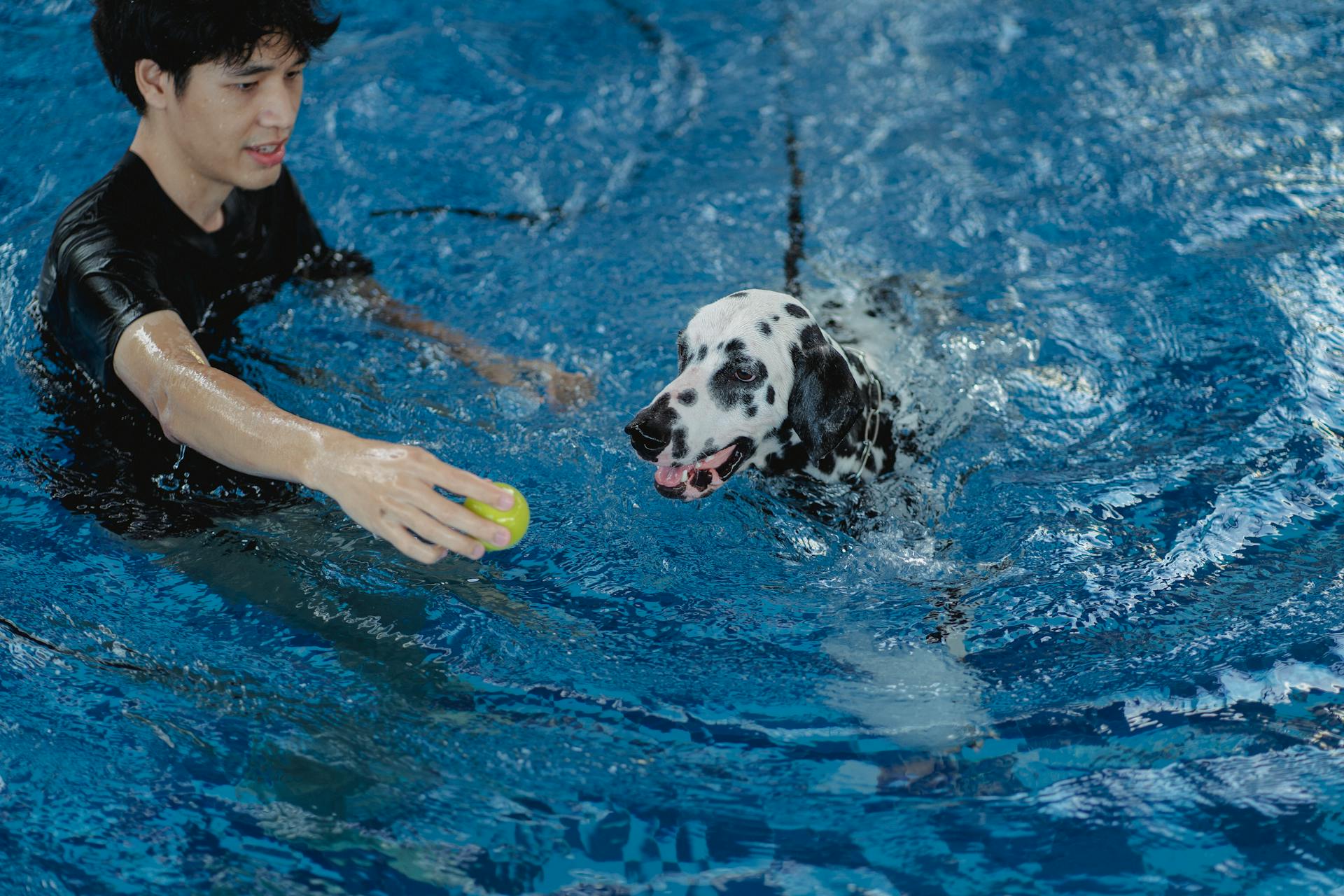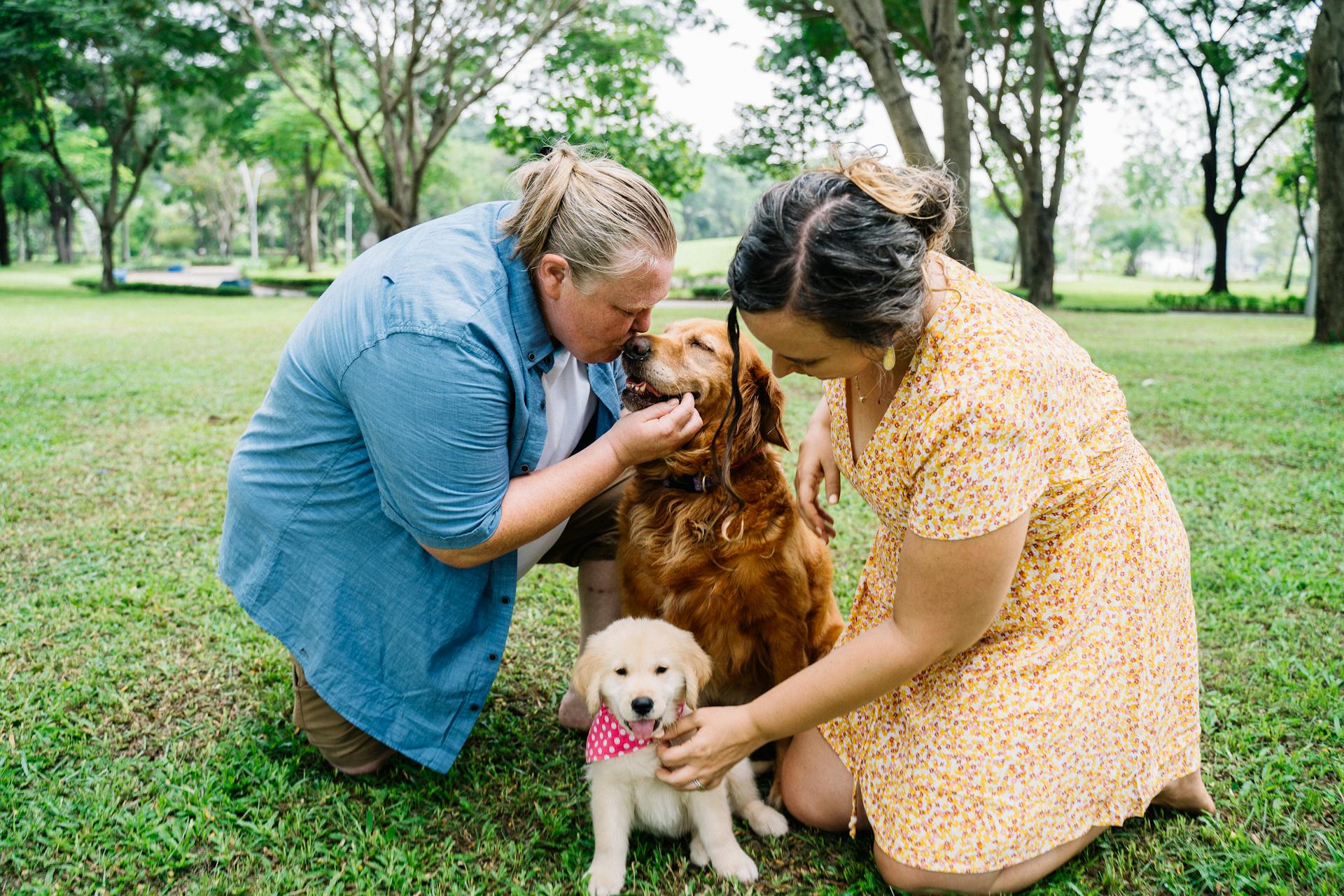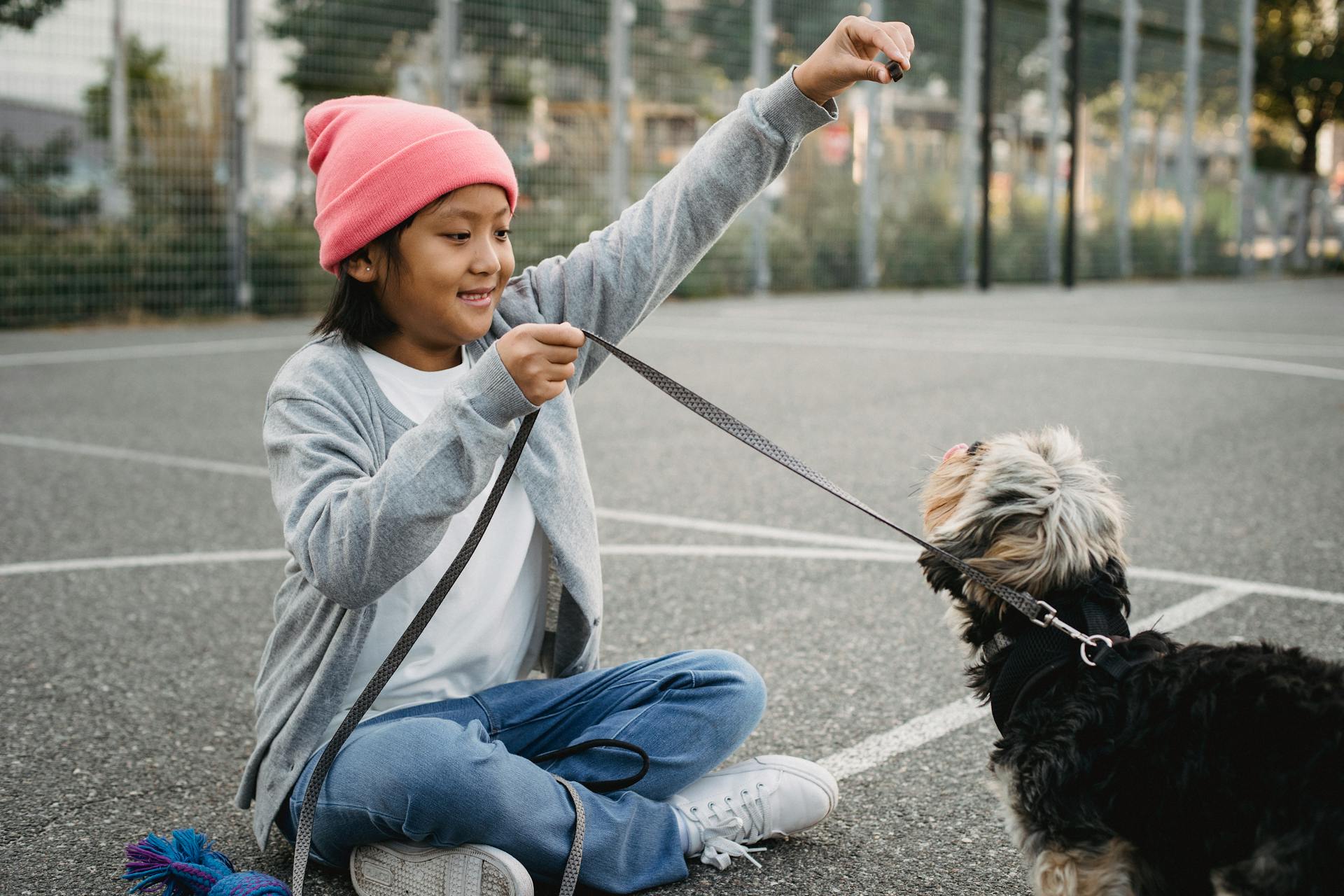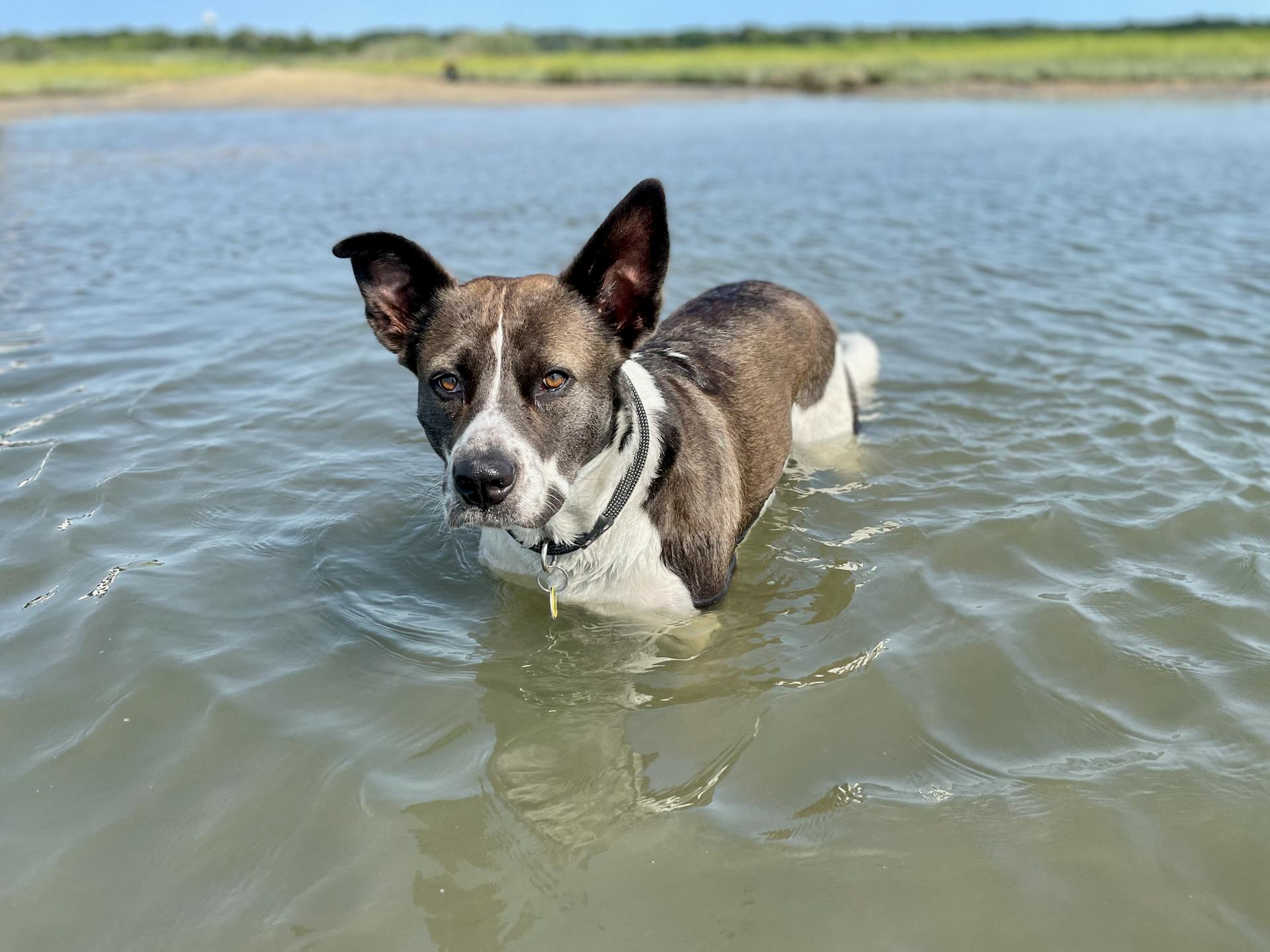
The Canine Good Citizen (CGC) program is a fantastic way to strengthen the bond between you and your furry friend. The program is designed to teach basic obedience skills and good manners in a controlled environment.
To become a certified Canine Good Citizen, your dog must pass a 10-question test, which evaluates their ability to perform tasks such as walking on a loose leash, sitting calmly, and ignoring distractions.
The CGC program is open to all breeds and mixes, and it's a great way to socialize your dog and help them become a well-behaved member of your community.
Explore further: Good Citizen Dog Training
What is Canine Good Citizen
The Canine Good Citizen (CGC) program is a 10-skill test that teaches good manners to dogs and responsible dog ownership to their owners. It's designed to help you and your dog be the best you can be together.
The CGC program is offered by the American Kennel Club (AKC) and has been around since 1989. The program has become the model for similar programs around the world.
Recommended read: 6 Week Dog Training Program
To earn a CGC, a dog and handler team must pass a short behavioral evaluation of less than half an hour. If they pass, they earn a Canine Good Citizen certificate, which many people represent after the dog's name, abbreviating it as CGC.
The evaluation consists of ten objectives, including accepting a friendly stranger, sitting politely for petting, and calmly enduring supervised separation from the owner. All items must be completed satisfactorily or the team fails.
Here are the ten objectives of the CGC evaluation:
- Accepting a friendly stranger.
- Sitting politely for petting.
- Allowing basic grooming procedures.
- Walking on a loose lead.
- Walking through a crowd.
- Sitting and lying down on command and staying in place.
- Coming when called.
- Reacting appropriately to walking by a dog and person.
- Reacting appropriately to distractions.
- Calmly enduring supervised separation from the owner.
Dogs don't have to be registered with the AKC to earn a CGC, nor do they have to be purebred or registered with any canine organization. The goal is to promote responsible dog ownership for all dogs.
Preparing for the Test
You'll need to find an approved evaluator in your area to administer the 10-point CGC test.
It's essential to practice with your dog beforehand, whether you've completed CGC classes, worked with a private trainer, or practiced at home.
Class & Test

You'll need to take the 10-point CGC test with an approved evaluator in your area once you and your dog are ready. This is the next step after completing CGC classes or practicing at home.
The test requires you and your dog to walk through a crowd of people politely, showing interest but not being shy or over excited. You can talk to your dog as you navigate the crowd and use a "Watch Me" or "Look" cue if needed.
Encouragement is allowed during the test, but be sure to keep it to praise and petting only. No food, treats, or toys are permitted, even if they usually provide valuable reinforcement or encouragement.
Explore further: Canine Distemper Test
Basic Obedience Commands
To pass the exam, your dog needs to know Sit, Down, and Stay, and it's surprising how many dogs fail the Down part because their owners repeat the verbal cue multiple times.
You should say your cue just once and then help your dog out with a lure if they seem confused. Dogs don't understand the words we're saying until we teach them, and repeating the cue sounds like a different word.
Suggestion: When Do Dachshunds Calm down
It's easy to mistakenly train your dog to respond to "DownDownDown" instead of just "Down", which will get you in trouble come exam time. This same advice applies to the Sit cue.
For the Stay cue, say it once and then release your dog at the end of the exercise. If you've only taught a stop sign hand signal, your dog might break the Stay when you turn around and they can't see your hand.
You should teach a verbal cue that means "Stay there until I tell you to get up", which can be done by saying "Stay", rolling back into your heel, and coming back to reward your dog with a treat.
Check this out: Sit and Stay Dog Training
Walking on a Loose Lead
Walking on a loose lead can be a challenging skill to teach, but with patience and practice, your dog can learn to walk by your side without pulling on the leash. This skill can take up to six weeks to master, especially for dogs with no prior training.
To start, click and treat your dog for having a loose lead in a familiar place like your living room or backyard. This will help them associate the behavior with a reward.
The exam requires you to navigate a course with your dog on leash, including right and left turns, about turns, and stops. You're allowed to speak to your dog during the course to keep them focused and on task.
Make sure your dog is wearing a regular harness or collar, as training tools like treats or training collars are not allowed on the exam.
Equipment
When preparing your dog for the test, it's essential to choose the right equipment. All tests must be performed on leash.
For collars, make sure they fit well and are made of leather, fabric, or chain. Special training collars like pinch collars, head halters, and electronic collars are not permitted.
Body harnesses are allowed, but the evaluator will check to ensure they don't restrict the dog's movement. This means the harness shouldn't be so tight that the dog can't pull or jump up if it tries.
The evaluator will provide a 20-foot lead for the test. Don't forget to bring your dog's brush or comb to the test.
Additional reading: Can Neutering a Dog Help with Aggression
Benefits and Purpose
Training in Canine Good Citizen (CGC) has many benefits for you and your dog. By mastering skills like sit, down, and stay, you'll deepen your bond and become a more connected team.
The CGC title opens doors to more advanced dog sports and activities, making it a great introduction to new experiences. Your dog will also become a welcomed community member when out in public.
Passing the CGC exam proves that your dog has a basic level of training and can pass an unbiased test, which can be beneficial for insurance companies and some rental agencies.
A fresh viewpoint: When Do Cane Corsos Become Protective
Benefits of
Training in Canine Good Citizen (CGC) can have a profound impact on your relationship with your dog. By mastering skills like sit, down, and stay, you and your dog will become a more connected team.
The CGC title is a prerequisite for many therapy dog certifications, opening up new opportunities for you and your dog to make a positive difference in your community.
Why Test?

Testing for the CGC can open doors to more advanced training courses, as some organizations require it or an equivalent level of training.
Passing the CGC exam provides proof that your dog has a basic level of training, which can be a great confidence booster.
Some insurance companies will cover "banned breeds" if the dog has passed their CGC exam.
Passing the CGC exam can also give you bragging rights, as it's a notable achievement for you and your dog.
Test Items and Requirements
The Canine Good Citizen test is a 10-point evaluation that you'll take with an approved evaluator in your area. To be eligible, you don't need to have completed CGC classes or worked with a private trainer, just practice at home.
The test has specific items that will be evaluated, but the requirements aren't overly complicated. You'll need to find an approved evaluator who can administer the test.
To prepare for the test, it's essential to practice with your dog.
Test Process and Evaluation
To take the CGC test, you'll need to find an approved evaluator in your area. They'll assess your dog's behavior in a series of exercises.
The test is 10 points long, and you can prepare for it by taking CGC classes, working with a private trainer, or practicing at home.
For Evaluators
As a CGC Evaluator, it's essential to have all the necessary tools and resources at your fingertips. You can renew your status, download station signage, CGC brochures, or test summary forms from the one-stop website for Evaluators.
You can also explore how to become an Evaluator if you're new to the program. This is a great opportunity to learn about the process and requirements for evaluating dogs.
To ensure a smooth evaluation process, it's crucial to be familiar with the test requirements and rules. For instance, any dog that eliminates during testing must be marked failed, unless it's during test Item 10, which is held outdoors.
Check this out: Crate Training during the Day

You should also be aware of the dismissal criteria, which includes growling, snapping, biting, attacking, or attempting to attack a person or another dog.
Here's a quick reference guide to the test requirements:
- CGC Requirement #2: Sitting Politely for Petting
- CGC Requirement #3: Leash Walking
- Test Item 10: Walking on a Loose Leash
Remember to stay up-to-date with the latest information and resources to ensure a successful evaluation process.
Come When Called
Come When Called is a crucial aspect of the Canine Good Citizen (CGC) test. Your dog needs to come when called from 10 feet away.
To practice recall, start by calling your dog while sounding excited and reward them with a treat when they arrive. This will help your dog associate the recall cue with a positive outcome.
Practicing in a fenced-in area or on a long line is a good idea to ensure safety. It's also essential to focus on rewarding your dog for coming towards you, not for sitting or lying down.
If your dog won't move towards you, try calling them and then playfully running in the opposite direction. This can activate their desire to chase and get them moving towards you.
Explore further: Recall Training Dog
Test Process and Evaluation
The test process for the CGC exam is rigorous, but with practice and patience, you and your dog can succeed. The exam is divided into 10 requirements, each testing a different aspect of your dog's behavior and training.
You'll need to practice your dog's reaction to a strange dog, which can be challenging if you don't have access to unknown dogs. Practicing around a realistic stuffed dog can be a good alternative, and training a "Watch Me" or "Look" cue can also help distract your dog from the other dog.
The reaction to distraction part of the exam includes setting up several distractions, usually of the sound variety, to test your dog's reaction. A common distraction is a dropped metal dog bowl, so it's essential to practice with something similar to help your dog become desensitized to the noise.
To prepare for this part of the exam, start by dropping the bowl from a short distance onto a blanket-covered hard surface and pairing the sound with a treat. This will help your dog associate the noise with something positive.
Discover more: Will Spaying My Dog Help with Aggression
Frequently Asked Questions
Is Canine Good Citizen worth it?
Passing the Canine Good Citizen (CGC) test can open doors to new opportunities, such as therapy dog or service dog training, and advanced dog sports. It's a valuable investment for dog owners who want to enhance their pet's behavior and skills.
Is a Canine Good Citizen the same as a therapy dog?
No, a Canine Good Citizen (CGC) is a certification that demonstrates basic obedience and good manners, but it's not the same as a therapy dog certification. Passing CGC is often a prerequisite for therapy dog training, as it lays the foundation for more advanced training and socialization.
What is the difference between AKC Star puppy and Canine Good Citizen?
The main difference between AKC S.T.A.R. Puppy and Canine Good Citizen is that S.T.A.R. Puppy is an owner incentive program for basic training, while Canine Good Citizen allows evaluators to test dogs from any background.
How much is a CGC test for dogs?
The cost of a CGC test for dogs is $20, plus a $20 processing fee for the final certificate.
What age should a dog take the CGC?
There is no age limit for the CGC test, and puppies can be tested after completing all immunizations and boosters
Sources
- https://www.akc.org/products-services/training-programs/canine-good-citizen/
- https://dogtrainingnow.com/canine-good-citizen/
- https://fydogtraining.com/training-tips/2018/3/13/how-to-pass-your-canine-good-citizenship-exam
- https://en.wikipedia.org/wiki/Canine_Good_Citizen
- https://thinkpawsitivedog.com/product/advanced-canine-good-citizen-class/
Featured Images: pexels.com


